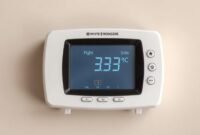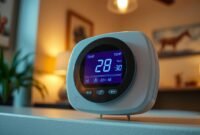“Why does my thermostat say wait?” is a common question among homeowners experiencing delays in their HVAC (heating, ventilation, and air conditioning) systems. Understanding the reasons behind this message can help troubleshoot issues effectively.
Well, thermostats often display “wait” to indicate a temporary delay in activating the heating or cooling system. Delving into the specifics of this message, its duration, and how to bypass it, especially on a Honeywell thermostat, can provide valuable insights for maintaining indoor comfort efficiently.
Why does My Thermostat Say Wait?
The appearance of a “wait” message on your thermostat typically indicates its effort to prevent premature activation of your home’s HVAC system. This cautionary measure arises when attempting to swiftly restart the thermostat after shutting it off.

From my experience as an HVAC technician, I’ve seen many instances where rapid adjustments to the HVAC settings caused disproportionate air pressure shifts within the compressor, necessitating a reset to stabilize.
This is a critical safeguard, as operating the HVAC system during this imbalance risks significant system damage, prompting potential professional repairs or replacement. The thermostat will continue displaying the waiting message until the compressor pressure normalizes for effective operation.
Additionally, this message could signify connectivity issues between the thermostat and the HVAC unit. Faulty wiring or external factors hindering AC unit power may render adjustments futile. For example, a homeowner once reported that their thermostat displayed the “wait” message after a sudden power outage in their neighborhood.
In this case, the issue was resolved by checking the circuit breaker and ensuring the thermostat had stable power. Other potential triggers for the waiting message include minor firmware glitches or depleted batteries requiring replacement, which are easily rectifiable issues.
Below is a table summarizing possible causes and their corresponding solutions for the “wait” message:
| Cause | Explanation | Suggested Action |
|---|---|---|
| Rapid Restart | Thermostat prevents compressor damage due to pressure imbalances. | Wait for the pressure to stabilize before the system reactivates. |
| Power Loss or Connectivity Issues | Faulty wiring, power interruptions, or communication issues between the thermostat and HVAC system. | The thermostat prevents compressor damage due to pressure imbalances. |
| Firmware Glitches or Depleted Batteries | Minor software bugs or low battery levels causing communication issues. | Update firmware or replace batteries. |
How Long Should the Thermostat Say Wait?
Every thermostat model features a distinct message displayed during a delay occurrence. This delay typically lasts up to five minutes under standard operating conditions.
How do you bypass Waiting on a Honeywell Thermostat?
Bypassing the Honeywell thermostat’s “wait” function is not recommended as a routine practice. This built-in delay protects the HVAC system from potential damage or undue wear.
However, if there is an urgent need to override the wait period, here are some steps you can consider (please note that exact procedures may vary based on the model):
1. Consult the Manual
Refer to the user manual of your Honeywell thermostat for specific instructions on overrides, as different models may have varying procedures.
2. Mode Adjustment
Sometimes, toggling the thermostat to “off” mode and then back to “heat” or “cool” can reset the wait period.
3. Circuit Breaker
In urgent situations, turning off the circuit breaker, powering the HVAC system and thermostat, waiting momentarily, and then restoring power can reset the system, although this method is somewhat drastic.
4. Direct Override
Certain Honeywell thermostats offer a direct bypass of the wait period through the settings menu, typically accessible by selecting the “test” mode, if available. This mode is commonly utilized for troubleshooting or system verification.
5. Programmable Schedule
For programmable thermostats, temporarily adjusting the programmed settings may accelerate activation. Set the desired temperature for a near-future period, potentially prompting the system to engage without the usual delay.
It is essential to remember that while these techniques may provide temporary solutions, the “wait” feature is integral to the system’s optimal functioning. Frequent bypassing can compromise system efficiency and lead to more significant issues over time.
If you perceive the wait feature as overly conservative, it is advisable to consult a professional to adjust delay settings or address any underlying issues causing prolonged wait times. Additionally, if you regularly find the wait time inconvenient, upgrading to a smart thermostat capable of more adaptive temperature management may be a worthwhile consideration.
In conclusion, understanding the nuances of the “wait” phase in a Honeywell thermostat can aid in effectively troubleshooting HVAC delays. While bypassing this feature is not advisable, knowing how to address it can be valuable. Consult the manual, adjust settings cautiously, and prioritize system integrity to maintain optimal indoor comfort and functionality!


